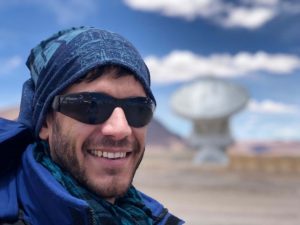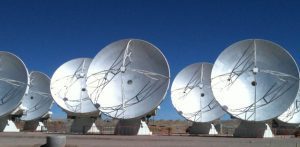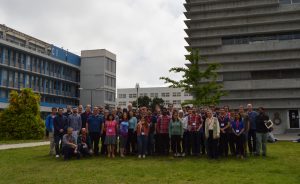The national Portuguese Research Council (FCT, Fundação Ciência e Tecnologia) is opening a call for research contracts within different areas of research for different profiles: Junior, Assistant, Principal, and Coordinating researcher. The positions are up to 6 years and the candidates need support from a host institution in Portugal.
The Institute of Astronomy would be very keen to support candidatures, providing full support to the potential candidates. Deadline 26th of February 2020.
The details are here:
http://www.iastro.pt/ia/jobDetails.html?ID=136 
All posts by almacp
PACE at the All-Hands meeting 2019
In the first week of November, PACE participated in the annual meeting of the European ALMA Network, hosted this year by the German ARC Node of Bonn. With the magnificent view of the Rhine valley in Konigswinter, representatives of different European Institutions discussed the status and future plans for ALMA development. After the successful ALMA meeting in Cagliari and with new ideas in mind, the meeting has planned future development for ALMA up to 2030, assuring its role at the forefront of astronomical research.
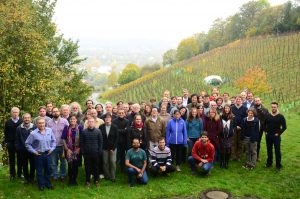
ALMA Director visited PACE
The new ALMA director Dr. Sean Dougherty, appointed in February 2018, visited the Portuguese ALMA Center of Expertise at the end of October.
Dougherty is a renowned radio astronomer, former director of the Dominion Radio Astrophysical Observatory, and Canada’s national radio astronomy facility. He also led the construction and delivery of the WIDAR correlator for the Karl G. Jansky Very Large Array (JVLA) and is currently leading the international consortium designing the correlator-beam former for the Square Kilometer Array (SKA).
During his visit PACE members had the opportunity to show our current activities and a brief summary of the past achievements and future challenges. In the afternoon the Director gave a plenary talk at the Faculty of Science of the University of Lisbon, explaining to the audience the successes and the new science opened in the last 10 years by this fantastic facility.

Messias has come back!
ALMA-ACA Supplemental Call for Proposals
A Supplemental Call for ACA telescopes is open to use standard observing modes, as allowed for ACA stand-alone proposals in the Main Call. Proposals may request to use the 7-m array only or the 7-m array plus Total Power array.
All proposals accepted in the Cycle 7 Supplemental Call will receive priority Grade “C” and will have lower observing priority than ACA proposals accepted in the Cycle 7 Main Call.
The ALMA Cycle 7 proposal submission deadline is 15:00 UT on Tuesday, 1 October 2019.
ALMA Cycle 7 is currently scheduled from October 2019 to September 2020. Proposals accepted in the Supplemental Call will be scheduled for observations between January 2020 and September 2020. Further details can be found on the ESO website.
ALMA-related contract opportunity in PACE
Portuguese nationals, foreign and stateless persons may submit applications to this selection procedure, provided they hold a doctoral degree in Astronomy and Astrophysics or akin areas, have specialised skills and/or expertise in the field of galaxy formation and evolution, and fully comply with the following requirements:
a) The PhD must have been granted at least 3 years ago.
b) Demonstrated scientific and/or professional experience in the area of galaxy formation and evolution, namely the identification and characterization of their AGN activity;
c) The candidate must also have a significant experience in the obtaining, processing and analysis of ALMA observations;
Details about the position available here:
PACE members at the IAU Symposium in Viana do Castelo.
PACE Members attended the IAU Symposium “Uncovering early galaxy evolution in the ALMA and JWST era”, hosted in Viana do Castelo, Portugal, from 3-7 June 2019.
This symposium brought together community of theoretical and observational experts to discuss how we can make the most of ALMA and JWST synergies in advancing our understanding of galaxy evolution in the young Universe during the next decade.
PACE members presented various posters, fostering the discussion about possible synergies between ALMA and future facilities in construction or soon available for the scientific community.
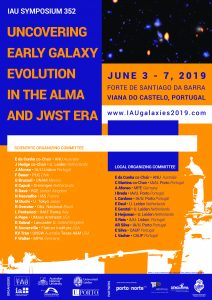
A polarization workshop for PACErs
PACE member participated in the Polarization Workshop, held in Garching in the last week of May. Experts from the European ALMA Regional Center Network meet at ESO to discuss and improve the procedure to validate ALMA data observed in full polarization mode, a challenging observing technique offered by the ALMA observatory in the past Cycles. The workshop will trigger a more efficient and thorough analysis for such type of data, increasing the more and more the scientific impact of ALMA in the field of Observational Astrophysics.

SPARCS Meeting in Lisbon
First Results from the Event Horizon Telescope. Press Conference on 10th of April
The Event Horizon Telescope (EHT) collaboration will present the groundbreaking results on 10 April 2019 in simultaneous press conferences worldwide.
The EU conference will be streamed online on the ESO website, by the ERC, and on social media. Questions will also be taken from social media using the hashtag #AskEHTeu.
A total of six major press conferences will be held simultaneously around the globe in Belgium (Brussels, English), Chile (Santiago, Spanish), Shanghai (Mandarin), Japan (Tokyo, Japanese), Taipei (Mandarin), and USA (Washington, D.C., English).
The goal of the observations was to image, for the very first time, the shadow of the event horizon of the supermassive black hole at the centre of the Milky Way, as well as to study the properties of the accretion and outflow around the Galactic Centre. The Atacama Large Millimeter/Submillimeter Array the world’s most sensitive facility for millimeter/submillimeter astronomical observations, and plays a key role in the EHT network.
More details in the ESO dedicated page.
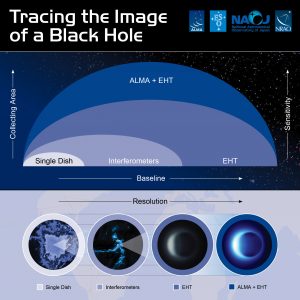
Credit: NRAO

